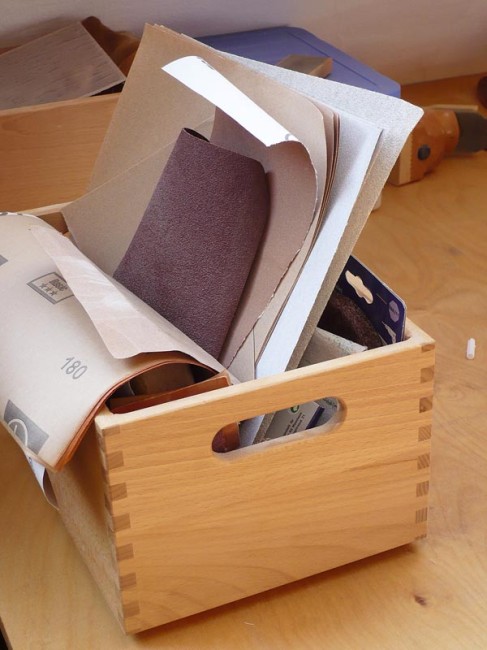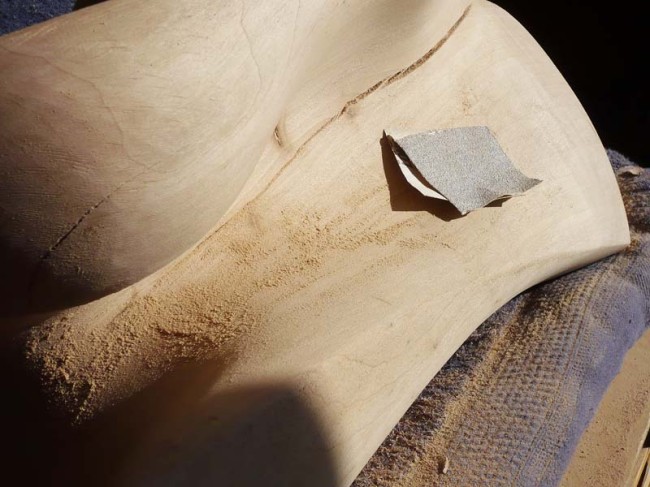 Grinding with sand paper usually is the final stage of making a sculpture for me. The last step of letting go. But again there are decisions to be made: How smooth do I want to have the surface? How much should the woods grain stand out (needs very fine grinding)? In this phase it’s a lot about the look of the sculpture. And the solutions are different for different kinds of wood. And at some places I still need to work out details, e.g. a curve that does not flow as it should, or an edge that can be anything from sharp to rounded.
Grinding with sand paper usually is the final stage of making a sculpture for me. The last step of letting go. But again there are decisions to be made: How smooth do I want to have the surface? How much should the woods grain stand out (needs very fine grinding)? In this phase it’s a lot about the look of the sculpture. And the solutions are different for different kinds of wood. And at some places I still need to work out details, e.g. a curve that does not flow as it should, or an edge that can be anything from sharp to rounded.
The challenge with edges is, that they are no form in itself. An edge is defined by the two surfaces that form it. So when an edge doesn’t work, I need to work on the surfaces, not on the edge. Also it is not a line that you just see from one perspective. It is three-dimensional. If it works from one direction that doesn’t mean it works from the others. This often becomes apparent only when the edge is more defined in the grinding process. You can cheat, by rounding off the edge. I sometimes do that. But most of the time my ambition has the better of me and I go for perfection. That means going back to rasp or even gouge sometimes and working it out. It is a lot of work, making small corrections, looking again, making another correction, smoothing it, looking again, etc. But the satisfaction when I found a solution is worth it.
Even if an edge is going to be rounded at the end I start sharp, so that I can see these flaws, correct them and, as a last step, work on the edge itself. Edges play important roles in the expression of a sculpture. I guess our eyes are looking for these defining aspects (even though they are defined by the surfaces ☺). A sharp edge increases this impact. Rounding it softens the character of the whole form. The decision to round an edge is – kind of – reversible. But it means you have to do a lot of work on the two surfaces to make it sharp again, which at this late state is annoying. Think twice!

Sand paper is no fun for the skin of my hands either. But if I keep it on for a few days, the skin starts to thicken and protects itself. Wearing gloves in this phase is not an option. I need to feel the surface under the paper: every glitch and bump and dent. I think it is rather subconsciously that I reduce or increase pressure at different points as a reaction to what my fingers feel.
Talking about perfection. At the academy I heard a quote from a famous sculptor, that he intentionally leaves a flaw somewhere in his sculptures. His take on it was, that if they are perfect, they are dead. The flaw is, what makes the sculpture alive and interesting. A good example for this is an orb that has been manufactured by a computer-controlled machine. It would be a perfect orb and would look exactly like what it is: a dead manufactured object. An orb created by hand would never be perfect, but maybe near perfect. And this last bit of missing perfection is, what catches our attention. The difference between artful and artificial. The art lies in finding the right balance between striving for perfection and leaving the flaws. Leaving a flaw can look just sloppy, or just right. Often the wood helps me with that, with its cracks and holes and spots and glitches in the structure. The wood comes from a source that has lived. This life shines trough and I welcome it.